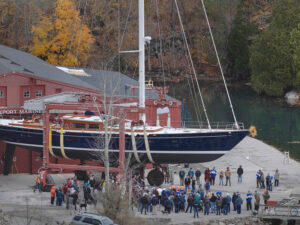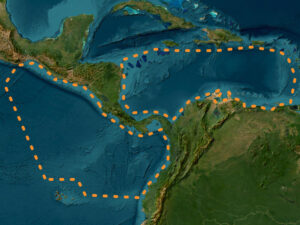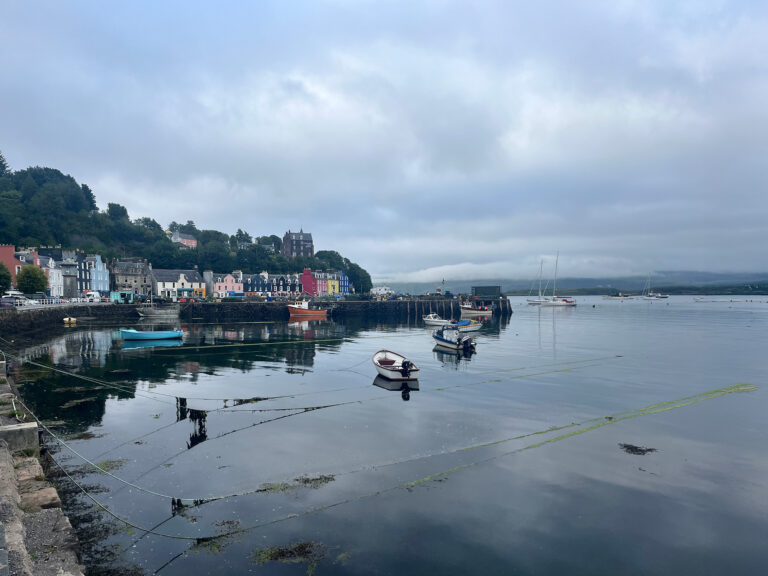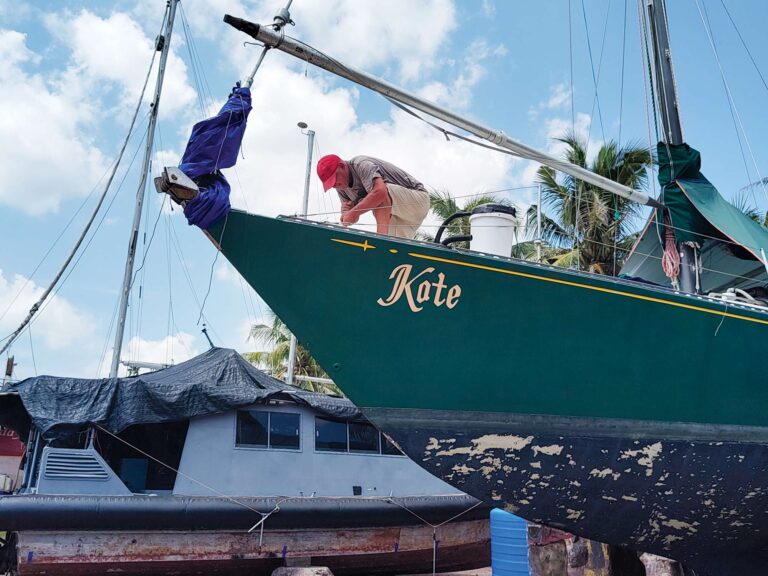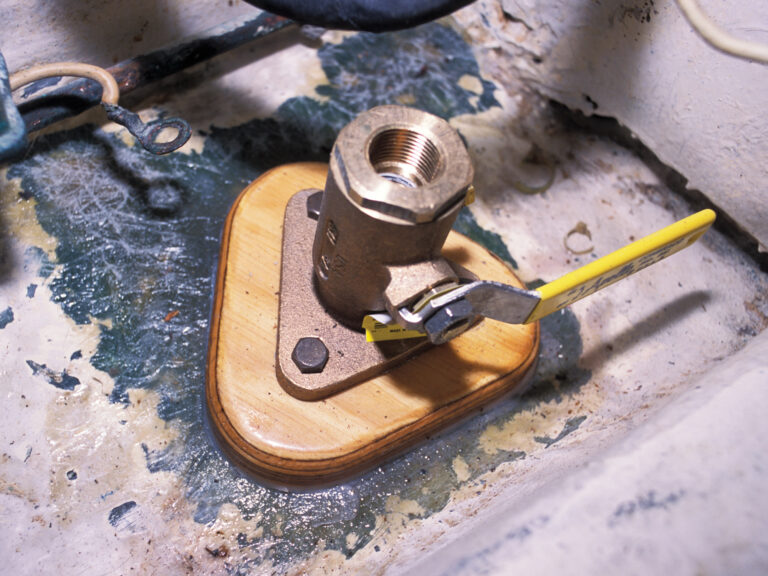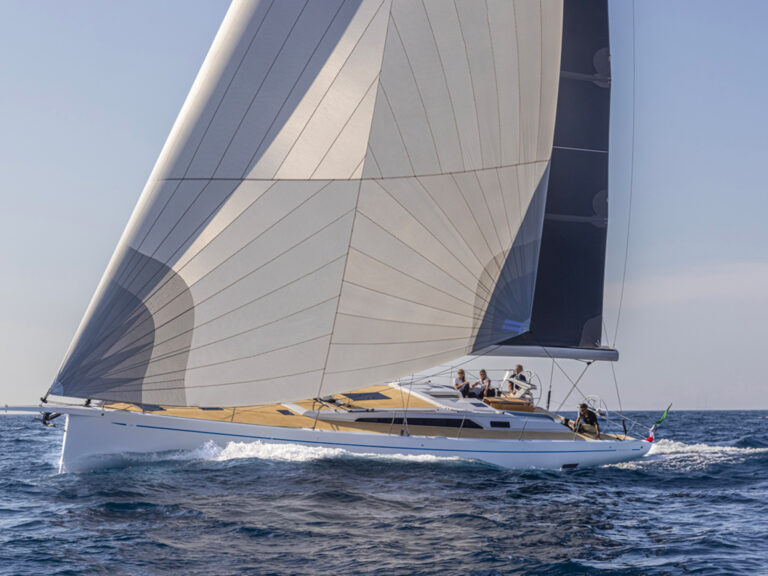
At some point, all of us classic-boat owners are faced with the expensive, time-consuming task of replacing the decks.
Teak is the preferred material, right?
Maybe. Maybe not.
I was faced with this predicament 20 years ago, when the teak decks on Searcher, our Bowman 57 ketch, needed to be replaced. The teak on the working decks was 30 years old and getting paper-thin. Bungs were missing, screwheads were showing, and the seam caulking was coming adrift.
So, I went looking for teak options. One alternative was cheap, plastic linoleum that tried to look like teak. There was real African teak or iroko, greenheart and tigerwood, but these, I thought, were better suited for a patio deck. Costa Rican teak might cost around $160 per square meter. I could have saved that money and instead painted the decks with antislip, but I never liked its look or effectiveness.
In 2004, I replaced the teak on the bow and working decks with Lewmar’s Treadmaster, an aggressively nonslip decking material with a diamond pattern. It comes in 3-by-4-foot sheets, is easily cut with a knife or shears, and is glued down over metal or fiberglass decks with a two-part epoxy. It’s maintenance-free and inexpensive.
A square meter of Treadmaster costs around $200. Teak is about the same, but far more labor-intensive and might require hiring professionals at $90 an hour. Treadmaster, I could install myself.
It took me a month to remove the old teak and fair the fiberglass decks, which were severely damaged during the removal process. I also had to remove and rebed the jib sheet tracks and other deck fittings.
Once the decks were faired, I drew out the pattern on the deck in pencil, cut out pieces of brown wrapping paper to fit, taped them down, and took a look. Nice. I then labeled the templates and the deck, and cut the Treadmaster to match. It took me a week to epoxy the Treadmaster panels in place, weighting them down with sandbags. Done.
Today, all I have to do is hose it off. But don’t fall on it, or you’ll wind up with a diamond imprint on your knees.
Another Option for Teak Decks
Five years later, the teak on the aft deck and the cockpit seats needed replacing. I wasn’t about to use Treadmaster here, with aesthetic considerations and soft behinds to take into account.
I found Stazo marinedeck, a Dutch product that’s available here in the United States. The distributor was in Thomaston, Maine, just 10 miles down the coast. This marine decking is made from compressed cork combined with a binder. It looks like teak (well, close enough) and comes in strips and sheets, all one-third of an inch thick. It does not absorb moisture, is much lighter, is a better insulator, is maintenance-free and is cooler underfoot than teak. After 15 years, all it needed was a light sanding to return to its original condition.
I also found it less expensive than teak, at $400 a square meter. It was easily cut and shaped, and I could do the installation myself.
For that project, it took me two weeks just to remove the teak and fair the fiberglass subsurface. Cutting and fitting the cork was fun, like putting together a jigsaw puzzle. This part, I did dry: cutting the strips, fitting them in place and numbering each one with corresponding numbers on the deck.
Then began the messy part: applying tubes of deck caulk in a caulking gun, spreading out the gooey stuff with a serrated trowel over a small section of deck, fitting a few strips in place and applying pressure, scraping up the goo that oozed out, and spreading it over the next section.
When I asked the guys at a nearby yard for suggestions, they told me they used their wives’ old dresses as smocks. “You’ll get this stuff all over yourself,” they warned. I did.
Once the cork was placed and rolled out, it needed a few days to cure. The next step involved filling and troweling the seams. This created a real mess. I began by taping the seams but then gave up, as troweling the caulk just spread the stuff outside the tape. The decks were covered in black goo.
After a few days, the seam compound had set, and I hit the entire deck with a belt sander. It was a joy to watch the new and now-clean decks emerge from the black mess I’d created.
After 14 years of ownership and three voyages down to and back from the Eastern Caribbean, I sold Searcher in 2014. The boat sat neglected by the buyer in a Belgian marina for eight years after that. Matthi Pieters, a Belgian shipwright, then acquired it, and over the next two years, he rebuilt a significant portion of the boat’s interior, excluding the decks.
Matthi shared his progress with me and other Bowman 57 owners in our Facebook group. He recently sent me photos and this report: “We had to do some work on the cork deck, but now it looks very good again. There were some little gaps in the seams, which we cut out and filled. Water had gotten under some planks in the cockpit, which we removed and re-bedded. After a light sanding, the cork looks new. Some of the Treadmaster decking had become porous and discolored. So, we painted it with a thin epoxy. The edges of some sections of the Treadmaster were lifting. We need to re-epoxy these to fix the edges. Next summer, we’ll repaint the entire deck. The best thing would be to replace the Treadmaster. But to save costs, we try it this way for now.”
I wrote to Matthi recently about a newer product: Treadmaster’s Treadcote, an epoxy paint. It’s Lewmar’s answer to restoring heavily weathered and stained original Treadmaster decking.
Searcher has been renamed We’ll Sea and is now back in the water, with a new engine and rebuilt interior. The jade-green hull is now painted light gray. Matthi and his family sailed We’ll Sea from Belgium to London this past summer, with plans for more ambitious adventures down the road.
She may have lost her teak, but she’s gained a new lease on life, and she’ll have a few more stories to tell from the other side of the spray.
Based in Maine, David H. Lyman has owned and sailed four yachts in his more than half a decade of cruising in the Atlantic and Caribbean.

